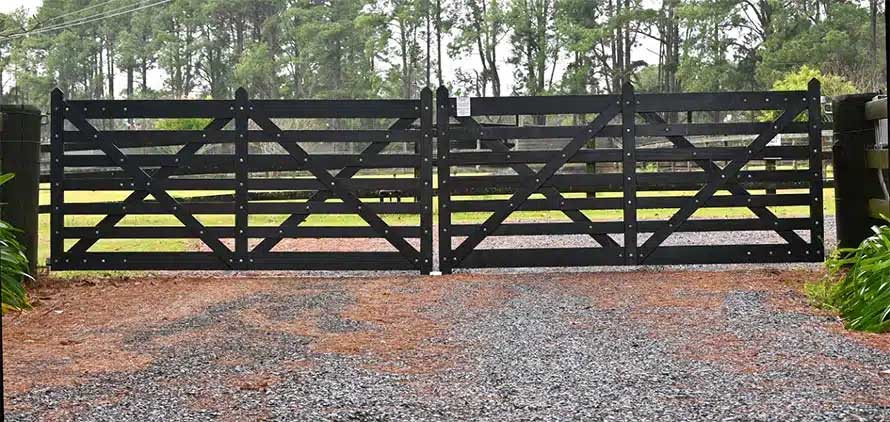
by Nikki Alvin-Smith for Horizon Structures
The effort involved in figuring out the right dimensions for the myriad of gates and entranceways needed at a horse farm and their careful installation is well worth the investment.
With this safety and security size guide, the effort involved in figuring out the right dimensions for the myriad of barn doors, gates and entranceways needed at a horse farm and their careful installation is well worth the investment.
The Main Gate(s)
Entranceways to the property that are too narrow will result in persistent issues with damage from users. Especially the heavy equipment that will commonly access the driveway to a horse property such as tractor-trailers full of hay or shavings, large horse trailers or trucks, tractors and various farm equipment.
The use of gates at the main entrance is a good idea as these can be securely closed when necessary to afford better protection and safety for both horses and humans residing on the farm. Houdini horses, neighborhood dogs on the loose, folks with nefarious intent to steal, wandering passers-by who choose not to pass by at all but come up the driveway to investigate, photo and even feed horses pastured alongside the driveway, can all be foiled by the use of closed gates.
Electrical management of the open/close necessity of these gates is commonly employed to avoid the need for frequent hopping in and out of vehicles to manage the task manually. Consider the topography of the ground (it needs to be level), and the fact that heavier gates will require back-up support on each side with possibly a second post.
Regardless of due care and attention by drivers, damage to the gates may occur. The risk of damage may be minimized by placing the gates well back from the edge of the driveway, perhaps protected by shrubbery planted on each side to serve as a soft barrier or large rocks placed just to the inside line.
Bear in mind that fancy, stone encased pillars look beautiful but if they take a hit these can be expensive to repair.
Standard driveway widths for a residential property are between 9 to 12 feet in the U.S.A., but for a horse or farm property it is wise to go much larger. A 24-foot width will serve well if you have the room. The more acute the turn off the road and the narrower or busier the road from which the vehicles must enter, the wider the gate width will ideally be built.
If you set the gate posts further to the inside of the property there will be less chance for damage as the turn into the entrance can be constructed as a softer curve than a gate post installed on the property line.
Wherever a gate is placed on a curve, extra distance from the edge of the driveway to the gate post/gate should be added. An additional 2 feet on each side of the driveway is a good average to work from but also consider the length of the vehicles and their likely turning radius.
Distance from the ground surface for gates should be between 3 to 6 inches, with much larger distances allowed if the property is situated in a snow region.
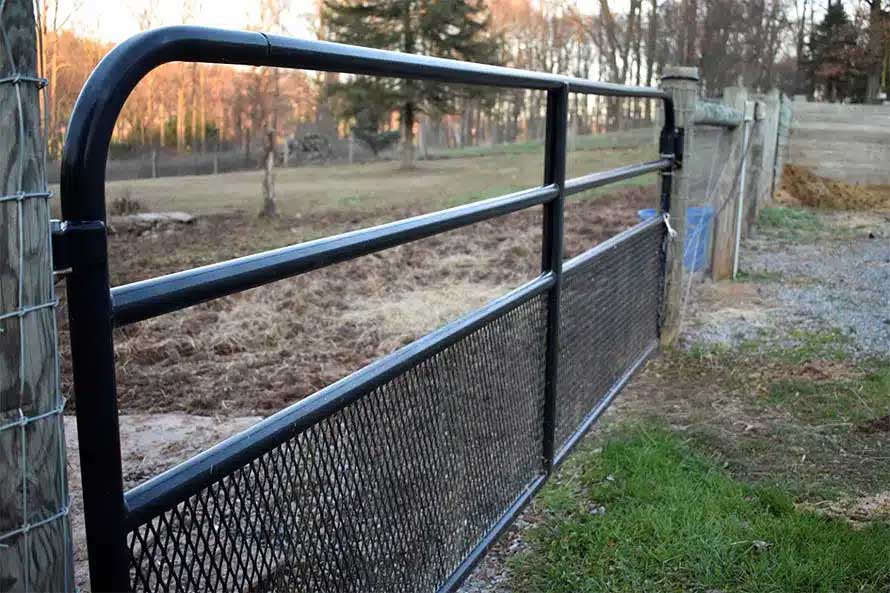
Design of the gates may include panels or bars, or mesh to deter dogs and smaller mammals. Attention should be paid to the distance between panels or bars in regard to safety for horse and human. Some building codes require certain parameters (less than 5” apart for bars to avoid young children trapping their heads between them when playing).
Cattle grids at entranceways to horse properties are a recipe for disaster for obvious reasons and should be avoided.
One Gate or Two
Obviously the wider the gate the heavier it will be to open and close. Wood gates are exceptionally heavy and can be unwieldy to manage, while light aluminum gates with large panels can be difficult to work with during high winds.
Farm style tube and panel gates should be effectively hinged for safety and to avoid simply being lifted off their hinges by trespassers. Iron, PVC or custom designed gates will all have different hinge requirements. When open, the gates should have a stand on which to rest the weight, especially if they are to be left open for any length of time to prevent them from ‘dropping’ or swinging back and forth during windy weather.
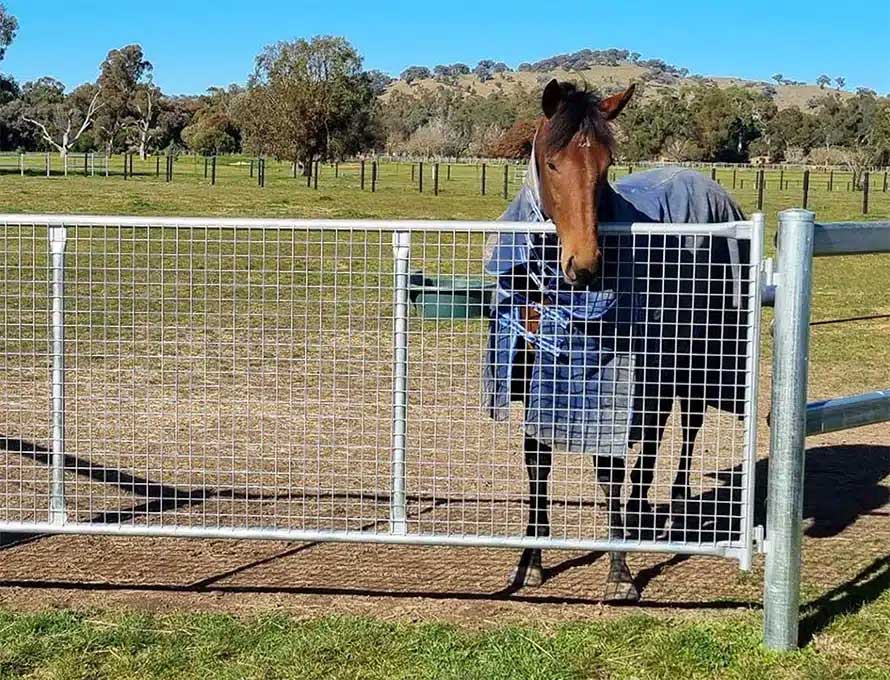
Sidebar: For tube/horse panel gate installation in paddocks/pastures and entranceways to the property, consider placing the top hinge facing down and the bottom hinge facing upward. This will also stop horses inadvertently (or advertently) lifting the gate off its hinges trying to graze beneath it. Though if a horse’s leg becomes trapped beneath it due to rolling too close to the gate it also means the gate will not pop off when the horse kicks or struggles to free himself.
Barn Doors
The main entry doors to the barn or other storage structures, need to be large enough to accommodate the use of ATVs, UTVs, and compact tractors.
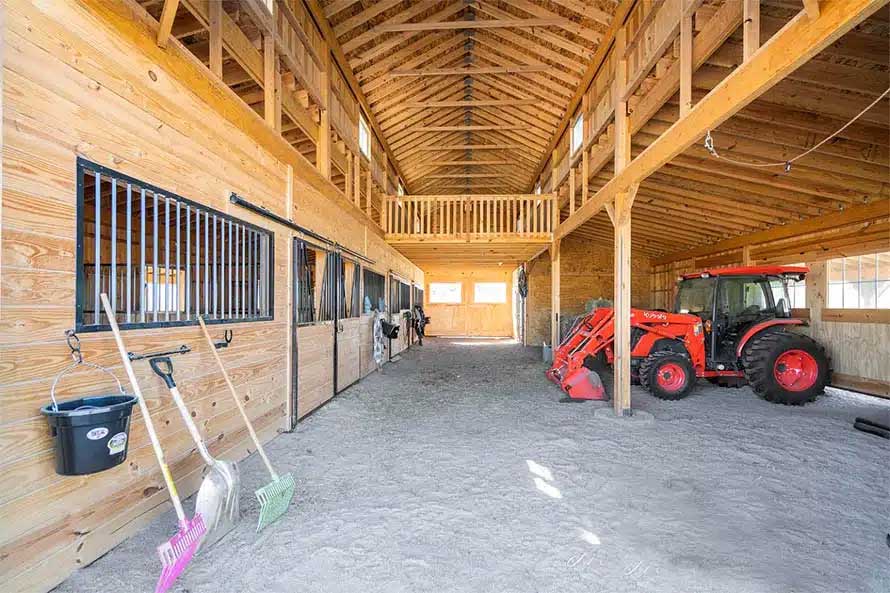
Center aisles or side aisles should be designed to be wide enough to make driving through the building easy to accomplish without hitting tack boxes, saddle racks or other barn accoutrements that may be placed on or against the front stall walls. If the barn design allows horses to have access over stall doors or front walls of the stalls to the aisle, the width of the ‘driving’ lane should be wide enough to ensure they cannot reach the equipment.
Standard barn door sizes and widths in center aisle barns range between 10 and 14 feet, but wider aisles should be incorporated in the design of high traffic barns with doors at the gable ends to match.
Sliding, swinging or electric overhead doors are all options for entry doors. The latter being useful in snow regions, although be aware metal doors can freeze to the ground during periods of cold weather. However, a manual override is a necessity in case of power outages for electrical doors.
Doors should generally be placed at the gable ends of the building to avoid snow building up in front of them making the building interior inaccessible, and to avoid puddling from rain shed off the roof. The installation of gutters is a great idea to remove excess water from above entryways.
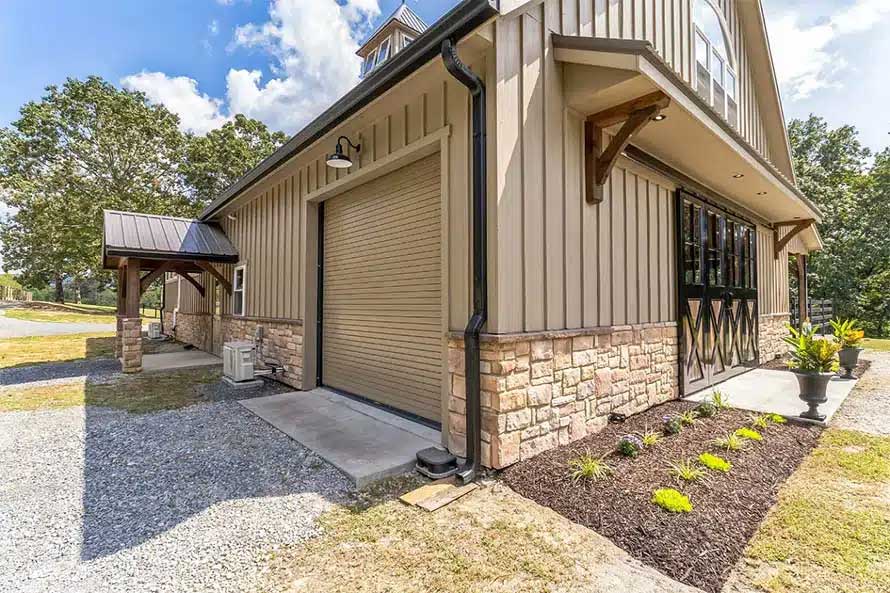
A smaller ‘person’ door or ‘horse’ door (4 foot or wider) can be included to one side of the gable end in larger barn builds, to avoid the necessity of opening big doors in adverse weather.
All doors should be properly locked back or secured in both open and closed positions to prevent them from moving/rattling or lifting off their tracks during high winds.
Stall Doors
A stall door is generally constructed with a standard width of 4 feet. However, for larger breeds of horses such as draft horses or warmbloods, an additional 6-12 inches can be added for ease of use.
When handling horses the safety-first approaches of avoiding swing stable doors and constructing the stall doorways wide enough for both horse and handler to navigate the gap easily without crowding each other should be employed.
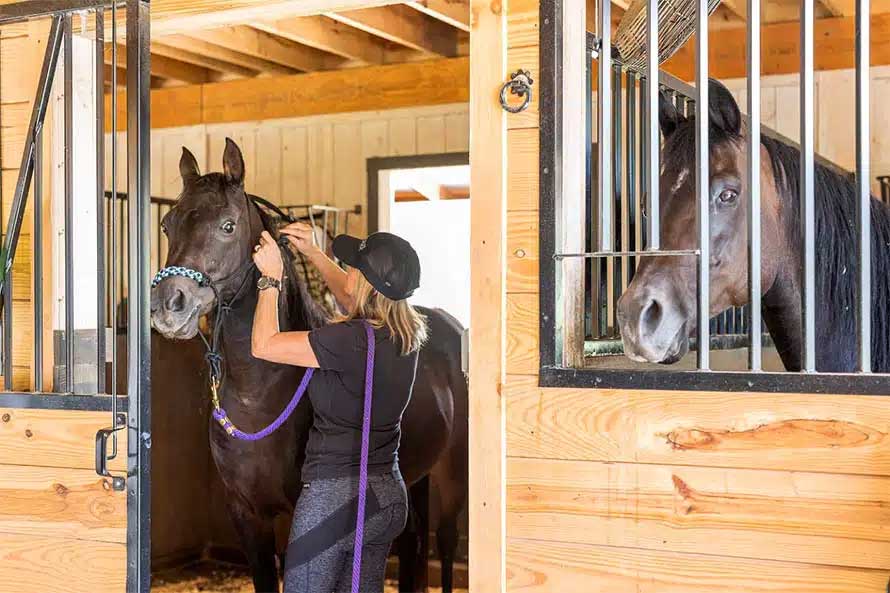
The myriad of stall door designs available are extensive but regardless of which you choose always consider safety first and ensure the door hardware is easy to operate for humans and hard to navigate for horses.
Where stall doors are not solid and grills are incorporated, a 4” gap is standard in horse stable door grills, though even this distance can be hazardous to a rearing foal.
Paddocks and Pastures
For paddocks and pastures the gate width is also of great importance. There is nothing more annoying than installing a horse friendly turnout gate of 8 to 10 feet and then figuring out you can’t fit your bushhog and tractor for a summer ‘deworm control’ mow or a tidy up in Fall.
Large pastures may even at some point be up for haymaking, where equipment that today’s farmers utilize can be 14 feet wide or more.
As paddock gates are always a point where horses will stand and hang out together waiting for feeding time to arrive or to come in from the heat of the day, it’s important to ensure gates are securely installed with sturdy posts and good quality hinges.
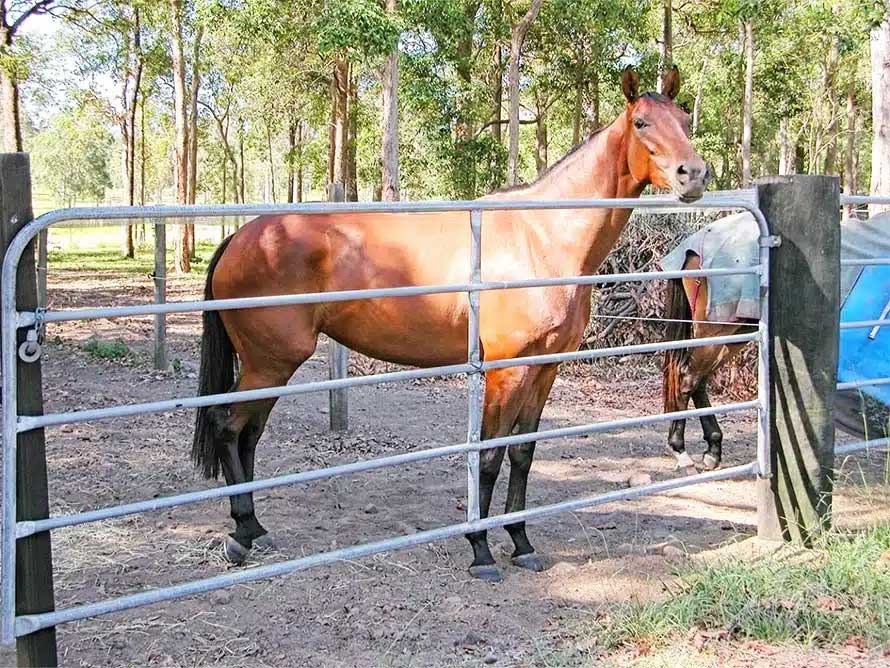
Very large entry gates to turn out areas will be difficult to manage when leading a horse.
As large gates are difficult to open and close (especially if doubled up to provide extra width), it is a good idea to have a standard barn door gate size of 8–10-feet for regular use when handling horses and a separate entrance for large equipment elsewhere with the larger gate options.
The latter should obviously also be safely latched and built, to avoid providing the temptation for an excited or frightened horse to run through them. The addition of a wire support above such gates is not advised due to the risk of injury from the wires should a horse choose to jump the gate.
The height of fencing and gates to grazing areas is equally as important as the width. The typical 5-foot set height of a panel/tube gate or traditional five bar gate with an allowance of 9-12 inches distance to the ground level is a typical configuration. The idea being that this distance will minimize the risk of a horse trapping a leg under the gate.
This article originally appeared on Horizon Structures and is published here with permission.
You can find more informative articles in our section on Tack & Farm.
Our curated EIE Amazon Store caters to all your needs for your horse.
































